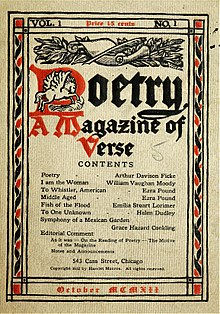Literary magazine

A literary magazine is a
History
The
Among the literary magazines that began in the early part of the 20th century is
Two of the most influential—though radically different—journals of the last half of the 20th century were
The middle-20th century saw a boom in the number of
The
Many prestigious awards exist for works published in literary magazines including the
Online literary magazines
SwiftCurrent, created in 1984, was the first online literary magazine. It functioned as more of a database of literary works than a literary publication.
There are thousands of online literary publications and it is difficult to judge the quality and overall impact of this relatively new publishing medium.[12]
Little magazines
Little magazines, or "small magazines", are literary magazines that often publish experimental literature and the non-conformist writings of relatively unknown writers. Typically they had small readership, were financially uncertain or non-commercial, were irregularly published and showcased artistic innovation.[13]
See also
- List of literary magazines
- Literary fiction
- Creative nonfiction
- Short story
- Anthology
- Poetry
- Non-fiction
References
- ISSN 0362-4331. Retrieved 2017-09-12.
- JSTOR 20132855.
- ^ "Library of Southern Literature: Antebellum Era". docsouth.unc.edu. Retrieved 2017-09-12.
- OCLC 39624837.
- ^ Charles, Ron. "America's oldest poetry journal celebrates 125 years of great verse". The Washington Post. Retrieved 2017-09-12.
- ^ "Urwa al-Wuthqa, al- | Encyclopedia.com". www.encyclopedia.com. Retrieved 2020-03-11.
- ^ "The Bellman". Onlinebooks. John Mark Ockerbloom. Retrieved 5 April 2023.
- ^ History Archived 2006-09-01 at the Wayback Machine
- ^ "SwiftCurrent". www2.iath.virginia.edu. Retrieved 2018-03-12.
- ^ "Volume 1, Number 1, April 1995". The Mississippi Review. University of Southern Mississippi. Archived from the original on 1998-01-28. Retrieved 31 January 2021.
- JSTOR 20132855.
- ^ "Technology, Genres, and Value Change:the Case of Literary Magazines" by S. Pauling and M. Nilan. Journal of the American Society for Information Science and Technology 57(7):662-672 doi10.1022/asi.20345
- ISBN 978-0-19-020109-8. Retrieved 11 July 2019.
Further reading
- Brooker, Peter; Thacker, Andrew. "The Oxford critical and cultural history of modernist magazines, Volume One: Britain and Ireland 1880–1955". ISBN 978-0-19-921115-9.
External links
- Council of Literary Magazines and Small Presses
- The Little Magazine a Hundred Years On A Reader's Report by Steve Evans
- Little Magazine Interview Index Housed at the University of Wisconsin–Madison Special Collections, the Little Magazine Collection, one of the most extensive of its kind in the United States, includes approximately 7,000 English-language literary magazines published in the United States, Great Britain, Canada, and Australia/New Zealand, mostly in the 20th century.
- Little Magazine Collection Blog Housed at the University of Wisconsin-Madison
- NewPages Guide to Literary Magazines in Print and Online.
- Poets & Writers Literary Magazine Database
- EWR: Literary Magazines Searchable listing of Literary Magazines
